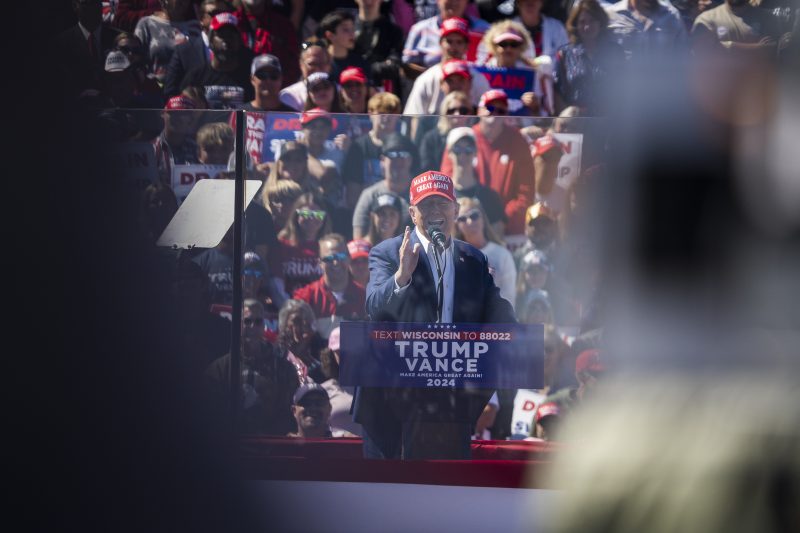Six months ago, Donald Trump presented us all with a Rorschach test by predicting a “bloodbath” if he loses the 2024 election. “Now, if I don’t get elected, it’s going to be a bloodbath for the whole — that’s going to be the least of it,” Trump said while discussing the economy and his tariff plan. “It’s going to be a bloodbath for the country.”
Those on the left largely took Trump literally, citing how his supporters have risen up violently before, on Jan. 6, 2021. Those on the right argued that Trump was just speaking figuratively. The latter said he was talking about a metaphorical bloodbath.
Trump has now invoked the prospect of blood again, even after his own blood was spilled just two months ago. As usual, his comments are infused with the kind of suggestiveness that allows plausible deniability.
And as usual, the point is less about what he specifically meant than that Trump continues to unmistakably toy with the prospect of righteous violence — something that we well know can inflame his supporters.
Trump said Saturday in Wisconsin that cracking down on undocumented immigrants would be a “bloody story.”
He referred to the recent sensational claims about a Venezuelan street gang taking over an apartment complex in a Denver suburb. (Police say this has not happened.)
“And you know, getting them out will be a bloody story,” Trump said. “They should never have been allowed to come into our country. Nobody checked them.”
What follows here is a familiar exercise. Trump has promised a mass deportation operation if he’s elected — something that basic logic and history suggests could be fraught and violent, as “Operation Wetback” was in the 1950s. Trump’s critics read into his comments a promise that his plan, too, would be a “bloody story.” Trump’s defenders, by contrast, note that this was an extended riff specifically about Colorado; they say Trump was merely predicting that will be the resolution there because of how violent the Venezuelan street gang is. (You can see the full video and transcript and judge for yourself.)
The point is less what Trump specifically meant than the fact that he keeps painting these kinds of pictures. Even after his personal experiences with violence, Trump hasn’t been dissuaded from injecting the prospect of blood and violence into our discourse, often with a sense of righteousness attached to it.
Some key examples:
- He predicted “riots” if denied the Republican presidential nomination at the party’s 2016 convention.
- He said in November 2020 that a ruling of the Pennsylvania Supreme Court would “induce violence in the streets.”
- He warned in August 2022 that “terrible things are going to happen” after the FBI searched Mar-a-Lago. (He also promoted Sen. Lindsey Graham’s (R-S.C.) prediction of “riots in the streets.”)
- He last year promoted a social media post in which a supporter said: “People my age and old[er] will physically fight for him this time. … They got my 6 and we Are Locked and LOADED.”
- Around the same time, he warned of “potential death & destruction” if he were indicted in Manhattan. He also posted, “OUR COUNTRY IS BEING DESTROYED, AS THEY TELL US TO BE PEACEFUL!”
- In January, he warned of “bedlam in the country” if he were pursued on federal charges that he tried to interfere in the 2020 election.
- After his conviction in the New York hush money case, he alluded to his supporters reaching “a breaking point.”
- His former defense secretary has said Trump mused privately about shooting and wounding racial justice protesters to disperse demonstrations, and other reporting indicates he floated similarly violent crackdowns on undocumented immigrants and demonstrators.
- He has previously encouraged police to rough up criminals; praised a Montana politician while citing his assault of a reporter; invoked a notorious quote about shooting looters; suggested gun-rights supporters would be the last line of defense against Hillary Clinton’s judicial picks if she were president; alluded to police, soldiers and bikers loyal to him no longer being peaceful; and repeatedly made light of a brutal attack on former House speaker Nancy Pelosi’s (D-Calif.) husband.
Trump even did that last one again last weekend, citing how the wall around the Pelosis’ residence “didn’t help too much with the problem she had.”
It’s abundantly clear that Trump would at the very least like us all to imagine — and in his supporters’ cases perhaps fantasize about — his allies rising up and law enforcement engaging in deadly clashes to right the wrongs of society and take care of the ne’er-do-wells. It has characterized his rhetoric for years.
And it yet again suggests ugly scenes could be ahead.

